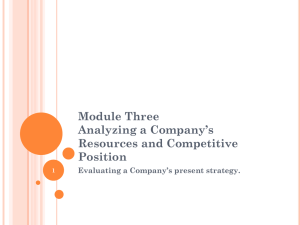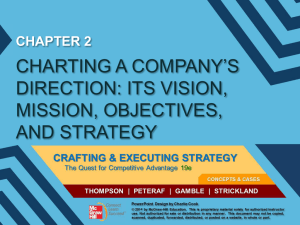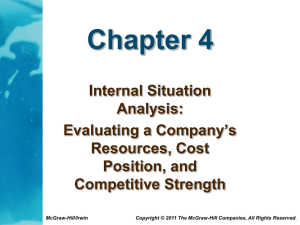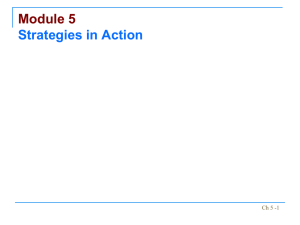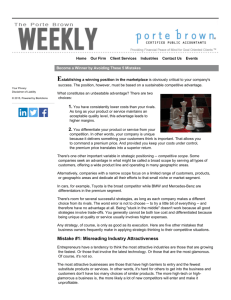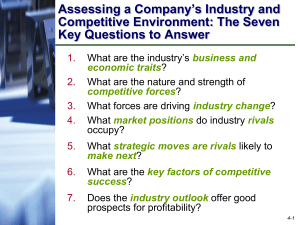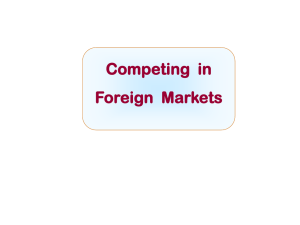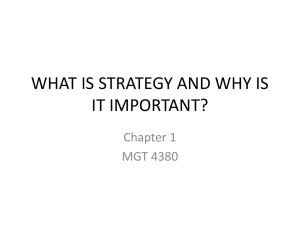STRATEGY Chapter 4 - Glo-Bus
advertisement
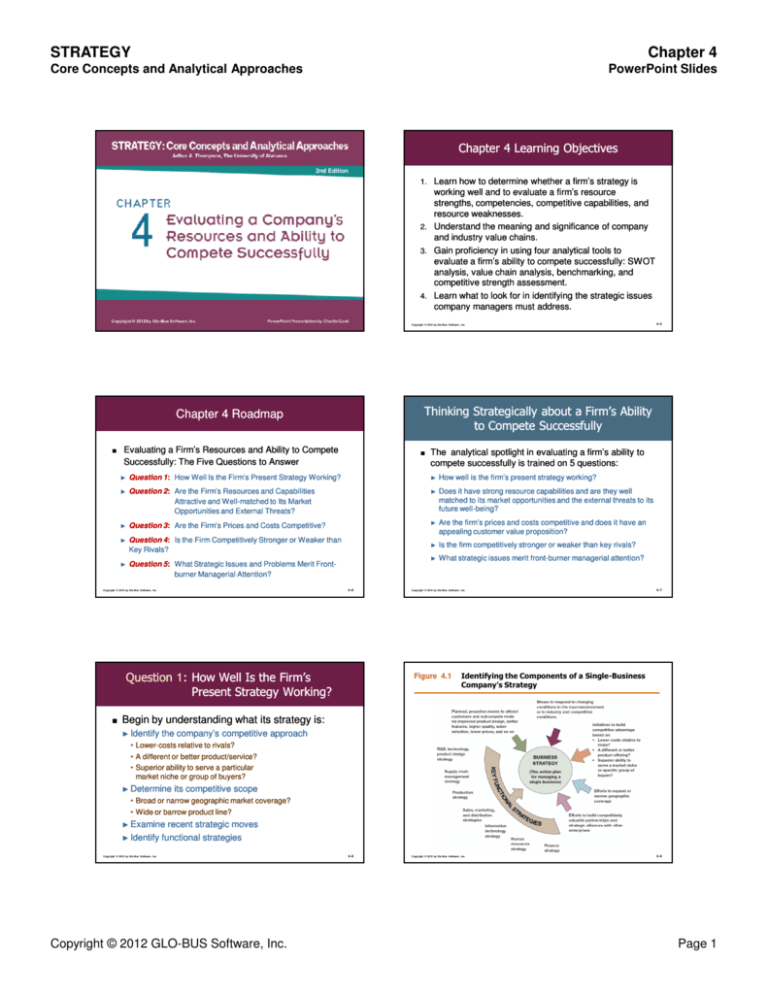
STRATEGY Chapter 4 Core Concepts and Analytical Approaches PowerPoint Slides Chapter 4 Learning Objectives 2nd Edition 1. Learn how to determine whether a firm’s strategy is working well and to evaluate a firm’s resource strengths, competencies, competitive capabilities, and resource weaknesses. 2. Understand the meaning and significance of company and industry value chains. 3. Gain proficiency in using four analytical tools to evaluate a firm’s ability to compete successfully: SWOT analysis, value chain analysis, benchmarking, and competitive strength assessment. 4. Learn what to look for in identifying the strategic issues company managers must address. Copyright © 2012 by Glo-Bus Software, Inc. Thinking Strategically about a Firm’s Ability to Compete Successfully Chapter 4 Roadmap ■ Evaluating a Firm’s Resources and Ability to Compete ■ The analytical spotlight in evaluating a firm’s ability to Successfully: The Five Questions to Answer compete successfully is trained on 5 questions: ► Question 1: 1: How Well Is the Firm’s Present Strategy Working? ► How well is the firm’s present strategy working? ► Question 2: 2: Are the Firm’s Resources and Capabilities Attractive and WellWell-matched to Its Market Opportunities and External Threats? ► Does it have strong resource capabilities and are they well matched to its market opportunities and the external threats to its future wellwell-being? ► Question 3: 3: Are the Firm’s Prices and Costs Competitive? ► Are the firm’s prices and costs competitive and does it have an appealing customer value proposition? ► Question 4: 4: Is the Firm Competitively Stronger or Weaker than Key Rivals? ► Is the firm competitively stronger or weaker than key rivals? ► Question 5: 5: What Strategic Issues and Problems Merit FrontFrontburner Managerial Attention? What strategic issues merit frontfront-burner managerial attention? ► 4–6 Copyright © 2012 by Glo-Bus Software, Inc. 4–5 Question 1: How Well Is the Firm’s Present Strategy Working? Copyright © 2012 by Glo-Bus Software, Inc. Figure 4.1 4–7 Identifying the Components of a Single-Business Company’s Strategy ■ Begin by understanding what its strategy is: ► Identify the company’s competitive approach • Lower Lower--costs relative to rivals? • A different or better product/service? • Superior ability to serve a particular market niche or group of buyers? ► Determine its competitive scope • Broad or narrow geographic market coverage? • Wide or barrow product line? ► Examine ► Identify recent strategic moves functional strategies Copyright © 2012 by Glo-Bus Software, Inc. Copyright © 2012 GLO-BUS Software, Inc. 4–8 Copyright © 2012 by Glo-Bus Software, Inc. 4–9 Page 1 STRATEGY Chapter 4 Core Concepts and Analytical Approaches PowerPoint Slides Key Indicators of How Well A Company’s Strategy Is Working Other Good Indicators of How Well a Company’s Strategy Is Working ■ Whether the firm’s sales are growing faster, slower, or at about the same pace as the market as a whole, thus resulting in a rising, eroding, or stable market share. ► Whether the firm is meeting or beating its financial and strategic performance targets ■ Whether the company is acquiring new customers at an attractive rate, as well as retaining existing customers. ► Whether the firm is an aboveabove-average industry performer. ■ Whether the firm’s image and reputation with its customers is growing stronger or weaker. ► W hether the firm is gaining customers and outcompeting one or more of its close rivals. ■ How well the company stacks up against rivals on product innovation, customer service, product quality, delivery time, price, getting newly developed products to market quickly, and other relevant factors affecting buyers’ choice of brands. ■ Whether the firm’s profit margins are increasing or decreasing and how well its margins compare to the profit margins of rival firms. ■ Trends in the firm’s net profits and return on investment and how these compare to the same trends for rival companies. ■ Whether the company’s overall financial strength and credit rating are improving or growing weaker. ■ Best indicators: Persistent shortfalls in meeting performance targets and weak performance relative to rivals are reliable warning signs that the firm has a weak strategy or suffers from poor strategy execution or both. Copyright © 2012 by Glo-Bus Software, Inc. 4–10 Evaluating a Company’s Financial Performance Copyright © 2012 by Glo-Bus Software, Inc. Table 4.1 4–11 Key Financial Ratios: How to Calculate Them and What They Mean ■ Accurate diagnosis of a company’s financial performance and financial statements requires some numbernumber-crunching. ■ The financial ratios in Table 4.1 are intended to provide guidance and direction in what numbers need to be calculated and how to interpret them. Copyright © 2012 by Glo-Bus Software, Inc. Table 4.1 4–12 Table 4.1 Key Financial Ratios: How to Calculate Them and What They Mean Copyright © 2012 by Glo-Bus Software, Inc. Copyright © 2012 GLO-BUS Software, Inc. Copyright © 2012 by Glo-Bus Software, Inc. 4–14 4–13 Key Financial Ratios: How to Calculate Them and What They Mean Copyright © 2012 by Glo-Bus Software, Inc. 4–15 Page 2 STRATEGY Chapter 4 Core Concepts and Analytical Approaches PowerPoint Slides Question 2: Are the Firm’s Resources and Capabilities Attractive and WellWell-matched to Its Market Opportunities and External Threats? Identifying Company Resource Strengths ■ A resource strength is something a firm does well ■ SWOT Analysis is a simple but powerful analytic tool for evaluating a whether a firm’s overall situation is fundamentally healthy or unhealthy. ► or an attribute that enhances its competitiveness ■ Resource strengths can take any of several forms: Zeros in on the firm’s resource Strengths and Weaknesses Weaknesses,, Opportunities,, and external Threats Threats.. market Opportunities ► ► ■ A firstfirst-rate SWOT analysis aids managers in crafting a ► strategy that: ► ► Capitalizes on the company’s resource strengths ► ► Aims squarely at capturing its best market opportunities ► ► Defends against external threats to the company’s future wellwellbeing and business prospects ► 4–16 Copyright © 2012 by Glo-Bus Software, Inc. A skill, specialized expertise, or competitively important capability Valuable physical assets Valuable human assets and intellectual capital Valuable organizational assets Valuable intangible assets An achievement or attribute that puts the firm in a position of market advantage Competitively valuable alliances or cooperative ventures 4–17 Copyright © 2012 by Glo-Bus Software, Inc. Assessing a Firm’s Strengths and Capabilities Core Concept A firm’s skill or proficiency in performing different facets of its operations can range from one of minimal ability to the other extreme of being able to perform the activity better than any other company in the industry. A company’s resource strengths represent its competitive assets and are big determinants of its competitiveness and ability to succeed in the marketplace.. marketplace ■ Core Concept: A firm has a competence in performing an activity when, over time, it gains the experience and knowknow-how to perform an activity consistently well and at acceptable cost. ■ Core Concept: A core competence is an activity that a firm performs quite well and that is also central to its strategy and competitiveness. ► A core competence is a more important resource than a competence because it adds power to a firm’s strategy and has a bigger positive impact on its market position and profitability. ■ Core Concept: A distinctive competence is a competitively important activity that a firm performs better than its rivals— rivals—it represents a competitively superior resource strength. 4–18 Copyright © 2012 by GloGlo-Bus Software, Inc. Core Concept Core Concept A firm has a competence in performing an activity when, over time, it gains the experience and knowknow-how to perform an activity consistently well and at acceptable cost. Copyright © 2012 by GloGlo-Bus Software, Inc. Copyright © 2012 GLO-BUS Software, Inc. 4–19 Copyright © 2012 by Glo-Bus Software, Inc. A core competence is an activity that a firm performs quite well and that is also central to its strategy and competitiveness. A core competence is a more important resource strength than a competence because it adds power to a firm’s strategy and has a bigger positive impact on its competitive strength and profitability.. profitability 4–20 Copyright © 2012 by GloGlo-Bus Software, Inc. 4–21 Page 3 STRATEGY Chapter 4 Core Concepts and Analytical Approaches PowerPoint Slides Building a Company Competence or Capability Core Concept A distinctive competence is a competitively important activity that a firm performs better than its rivals— rivals—it thus represents a competitively superior resource strength. strength. ■ A firm’s proficiency rises from mere ability to perform an activity to a true competence when it is able to perform the activity consistently well and at acceptable cost. cost. ► Achieving competence begins with deliberate efforts to simply develop the ability to perform an activity, however imperfectly or inefficiently. ► Then, as experience builds and the company gains proficiency to perform the activity consistently well and at an acceptable cost, cost, its ability evolves into a true competence and capability. Copyright © 2012 by GloGlo-Bus Software, Inc. 4–22 Where Are Company Competencies Located? resource strength than a competence because of its key role in the firm’s strategy and its contribution to the firm’s market success and profitability. expertise in a single discipline or function and are performed in a single organizational unit. ■ Other competencies are inherently multimulti-disciplinary and ► cross cross--functional, resulting from effective collaboration among people with different expertise in different organizational units. 4–24 The ability to speed new/nextnew/next-generation products to market ► Skills in producing a highhigh-quality product at a low cost The capability to fill customer orders accurately and swiftly. Copyright © 2012 by Glo-Bus Software, Inc. 4–25 Determining Whether a Firm Has a Competitively Attractive Collection of Resources ■ A Distinctive Competence ► Signifies greater proficiency than a core competence because it represents a level of proficiency that rivals do not have. ► Adds real punch and power to a firm’s strategy because it represents a competitively superior resource strength ■ It is important for a firm to identify which skills and proficiencies qualify as a competence competence,, which represent a core competence, competence, and which represent a distinctive competence.. competence Has potential for producing a competitive advantage when: when: • It relates to an activity important to market success • Rival companies do not have offsetting competencies • It is costly and timetime-consuming for rivals to imitate the competence Copyright © 2012 GLO-BUS Software, Inc. ► ► Why a Distinctive Competence Matters Copyright © 2012 by Glo-Bus Software, Inc. Most core competencies are grounded in crosscross-department combinations of knowledge and expertise rather than in the skills and efforts of a single department or work group. ■ Examples of Core Competencies: Virtually all organizational competencies are knowledge knowledge-based based,, residing in the intellectual capital of company personnel. ► Core Competencies ■ A Core Competence is a more competitively valuable ■ Some competencies relate to specific skills and Copyright © 2012 by Glo-Bus Software, Inc. 4–23 Copyright © 2012 by Glo-Bus Software, Inc. 4–26 ► Both core competencies and distinctive competencies are valuable and act to enhance a company’s competitiveness. ► Some competencies merely enable market survival because most rivals also have them. ► Not having an important competence or competitive capability that rivals have can result in competitive disadvantage. Copyright © 2012 by Glo-Bus Software, Inc. 4–27 Page 4 STRATEGY Chapter 4 Core Concepts and Analytical Approaches PowerPoint Slides Dynamic Capabilities— Capabilities— Four Ways to Test the Competitive Power of a Resource Strength or Capability The Importance of Keeping Company Competencies Freshly Honed and on the CuttingCutting-Edge ■ Why must a firm polish, update, or augment its current ■ There are four tests of the competitive power of a competencies and capabilities? ► To effectively respond to ongoing changes in customer needs and expectations ► To protect its long long--term competitiveness against the strategic maneuvering of rivals to win bigger sales and market shares. ► To help improve its performance over the longlong-term Important Point resource strength or capability: 1. Does the resource strength or capability have competitive value? value? 2. Do many or most rivals have much the same resources or capabilities? 3. Is the resource or capability hard to copy? 4. Can the resource strength be trumped by the different resource strengths and competitive capabilities of rivals? A firm requires a dynamically evolving portfolio of competencies and capabilities in order to sustain its competitiveness and help drive improvements in its performance. Core Concept 4–28 Copyright © 2012 by Glo-Bus Software, Inc. What to Look For in Identifying a Firm’s Resource Strengths and Competitive Capabilities ■ A powerful strategy ■ Core competencies in _______. ■ Superior intellectual capital relative to key rivals Cost advantages over rivals ■ A distinctive competence in _______. ■ ■ A product that is strongly differentiated from those of rivals ■ Skills in advertising and promotion ■ Product innovation capabilities Competencies and capabilities that are well matched to industry key success factors ■ Proven capabilities in improving production processes ■ A strong financial condition; ample financial resources for growth Good supply chain management capabilities ■ Good customer service capabilities ■ Strong brand name/image/reputation ■ Better product quality relative to rivals ■ An attractive customer base ■ ■ Proprietary technology/superior technological skills/important patents Wide geographic coverage and/or strong global distribution capability ■ Important alliances / joint ventures with other firms ■ ■ Copyright © 2012 by Glo-Bus Software, Inc. • • • • • • • • • • • • • • • • • • • 4–30 Copyright © 2012 GLO-BUS Software, Inc. Copyright © 2012 by Glo-Bus Software, Inc. 4–31 ■ Resource weaknesses relate to: ► Inferior or unproven skills, capabilities, expertise, or intellectual capital in important areas of the business. ► Deficiencies in competitively important physical, organizational, or intangible assets. ► Missing or competitively weak capabilities in key areas A firm’s resource strengths are central in delivering value to customers and winning business away from rivals. It is very difficult for rivals to outcompete a firm having powerful resources and capabilities that are hard to copy and hard to trump. trump. A strategy grounded in competitively superior resource strengths helps achieve a sustainable competitive advantage. Copyright © 2012 by Glo-Bus Software, Inc. A powerful strategy Core competencies in _______ A distinctive competence in _______ A product that is strongly differentiated from those of rivals Competencies and capabilities that are well matched to industry key success factors A strong financial condition; ample financial resources to grow the business Strong brand name image/company reputation An attractive customer base Proprietary technology / superior technological skills / important patents Superior intellectual capital relative to key rivals Cost advantages over rivals Skills in advertising and promotion Product innovation capabilities Proven capabilities in improving production processes Good supply chain management capabilities Good customer service capabilities Better product quality relative to rivals Wide geographic coverage and/or strong global distribution capability Alliances / joint ventures with other firms that provide access to valuable technology, competencies, and/or attractive geographic markets ■ A resource weakness, or competitive deficiency ► Is something a firm lacks, does poorly (in comparison to rivals) or a condition that puts it at a disadvantage in the marketplace. Because anchoring a firm’s strategy in its most valuable resource strengths gives the firm its best chances for competitive success ► 4–29 Identifying Company Resource Weaknesses and Competitive Deficiencies Why should a firm’s strategy be based on its most competitively powerful resource strengths and capabilities? ► Copyright © 2012 by Glo-Bus Software, Inc. Table 4.2 What to Look for in Identifying a Firm’s Resource Strengths Tying Strategy to Competitively Powerful Resource Strengths ► The degree of success a company enjoys in the marketplace hinges on the competitive power of its resources—the set of competencies, capabilities, and competitive assets at its command. 4–32 Copyright © 2012 by Glo-Bus Software, Inc. 4–33 Page 5 STRATEGY Chapter 4 Core Concepts and Analytical Approaches PowerPoint Slides What to Look For in Identifying a Company’s Resource Weaknesses and Competitive Deficiencies Core Concept A firm’s resource weaknesses are shortcomings that constitute competitive liabilities. liabilities. ■ No clear strategic direction ■ Weaker dealer network than key rivals and/or lack of adequate global distribution capability ■ Resources that are not well matched to industry key success factors ■ No well well--developed or proven core ■ Behind on product quality, R&D, and/or technological knowknow -how competencies Important Point: The degree to which a firm’s resource weaknesses make it competitively vulnerable depends on how much they matter in the marketplace and the extent to which they may be partially or wholly offset by the firm’s resource strengths. ■ A weak balance sheet; burdened with too much debt; ■ Losing market share because… ■ Higher overall unit costs relative to key competitors ■ Inferior intellectual capital relative to capabilities or features inferior to those of rivals ■ Too narrow a product line relative to rivals 4–34 business and pursue promising initiatives ► 4–37 Copyright © 2012 by Glo-Bus Software, Inc. ■ ■ ■ ► Match up well with the firm’s financial and organizational resource capabilities ■ ■ the best prospects for growth and profitability the most potential for competitive advantage ■ A firm should pass on a particular market opportunity unless it has or can acquire the resources and capabilities to capture it. Copyright © 2012 GLO-BUS Software, Inc. Be plentiful or scarce, fleeting or lasting Range from wildly attractive (an absolute “must” to pursue) to Marginally interesting (because of the high risks or large capital requirements or unappealing revenue growth and profit potentials) to Unsuitable (because the firm’s resource strengths and capabilities are ill ill--suited to capturing particular opportunities). What to Look For in Identifying a Company’s Market Opportunities at capturing good market opportunities, the opportunities most relevant to a company are those that: Rule 4–35 Copyright © 2012 by Glo-Bus Software, Inc. ► ■ While a firm’s strategy should always be aimed Copyright © 2012 by Glo-Bus Software, Inc. ■ Too much underutilized plant capacity situation without first identifying its market opportunities and appraising the growth and profit potential each one holds. ■ A firm’s market opportunities can 4–36 ► Present or obsolete facilities ■ Short on financial resources to grow the ■ Managers can’t properly tailor strategy to the firm’s Identifying a Firm’s Market Opportunities ► Offer ■ Plagued with internal operating problems Market Opportunities No clear strategic direction Resources that are not well matched to an industry’s key success factors No well-developed or proven core competencies A weak balance sheet; burdened with too much debt Higher overall unit costs relative to key competitors Weak or unproven product innovation capabilities A product/service with ho-hum attributes or features inferior to those of rivals Too narrow a product line relative to rivals Weak brand image or reputation Weaker dealer network than key rivals and/or inadequate global distribution capability Behind on product quality, R&D, and/or technological know-how In the wrong strategic group Losing market share because… Lack of management depth Inferior intellectual capital relative to rivals Subpar profitability because… Plagued with internal operating problems or obsolete facilities Short on financial resources to grow the business and pursue promising initiatives Too much underutilized plant capacity Copyright © 2012 by Glo-Bus Software, Inc. rivals ■ Subpar profitability because… ■ A product/service with hoho-hum attributes Table 4.2 What to Look for in Identifying a Firm’s Weaknesses • • • • • • • • • • • • • • • • • • • ■ Lack of management depth ■ Weak or unproven product innovation ■ Weak brand image or reputation Copyright © 2012 by GloGlo-Bus Software, Inc. ■ In the wrong strategic group 4–38 Openings to win market share from rivals Sharply rising buyer demand for the industry’s product Serving additional customer groups or market segments Expanding into new geographic markets Expanding the firm’s product line to meet a broader range of customer needs Utilizing firm’s present skills or technological knowknow-how to enter new product lines or new businesses Copyright © 2012 by Glo-Bus Software, Inc. ■ Online sales via the Internet ■ Integrating forward or backward ■ Falling trade barriers in attractive foreign markets ■ Acquiring rivals with attractive technological expertise or capabilities ■ Entering into alliances or joint ventures to expand the firm’s market coverage or boost its competitive capability ■ Openings to exploit emerging new technologies 4–39 Page 6 STRATEGY Chapter 4 Core Concepts and Analytical Approaches PowerPoint Slides Identifying External Threats to a Firm’s Future Profitability Table 4.2 What to Look for in Identifying Market Opportunities • Openings to win market share from rivals • Sharply rising buyer demand for the industry’s product ■ Factors in a firm’s external environment can pose • Serving additional customer groups or market segments threats to its profitability and competitive wellwell-being • Expanding into new geographic markets • Expanding the company’s product line to meet a broader range of customer needs • Utilizing existing company skills or technological knowhow to enter new product lines or new businesses • Online sales via the Internet ■ External threats may pose no more than a moderate degree of adversity, or they may be so imposing as to make a firm’s situation and outlook quite tenuous. ■ On rare occasions, market shocks can give birth to a • Integrating forward or backward • Falling trade barriers in attractive foreign markets • Acquiring rival firms or companies with attractive technological expertise or capabilities sudden-death threat that throws a firm into an suddenimmediate crisis and battle to survive. • Entering into alliances or joint ventures to expand the firm’s market coverage or boost its competitive capability • Openings to exploit emerging new technologies 4–40 Copyright © 2012 by Glo-Bus Software, Inc. What to Look For in Identifying External Threats to a Firm’s Future Profitability Copyright © 2012 by Glo-Bus Software, Inc. 4–41 Table 4.2 What to Look for in Identifying External Threats • Increasing intensity of competition among industry rivals—may squeeze profit margins • Slowdowns in market growth • Likely entry of potent new competitors Increasing intensity of competition among industry rivals— rivals—may squeeze profit margins ■ ■ Slowdowns in market growth ■ ■ Likely entry of potent new competitors Vulnerability to unfavorable industry driving forces ■ Loss of sales to substitute products Restrictive trade policies on the part of foreign governments ■ • Restrictive trade policies on the part of foreign governments Growing bargaining power of customers or suppliers Costly new regulatory requirements ■ Tight credit conditions • Tight credit conditions ■ Rising energy prices • Rising energy prices ■ ■ ■ ■ A shift in buyer needs and tastes away from the industry’s product Adverse demographic changes that threaten to curtail demand for the industry’s product Copyright © 2012 by Glo-Bus Software, Inc. • Loss of sales to substitute products • Growing bargaining power of customers or suppliers • A shift in buyer needs and tastes away from the industry’s product • Adverse demographic changes that threaten to curtail demand for the industry’s product • Vulnerability to unfavorable industry driving forces • Costly new regulatory requirements 4–42 Copyright © 2012 by Glo-Bus Software, Inc. 4–43 The Second Step of SWOT Analysis: Drawing Conclusions from the Four Lists Figure 4.2 The Three Steps of SWOT Analysis: Identify, Draw Conclusions, Translate into Strategic Action What conclusions can be drawn from the four SWOT lists is often revealed in the answers to the following questions: ■ What are the attractive aspects of the firm’s situation? ■ What aspects are of the most concern? ■ Could one or more of the firm’s weaknesses and competitive deficiencies prove fatal if not remedied, or are they either inconsequential or correctable? ■ Do the firm’s resource strengths and competitive capabilities outweigh its resource weaknesses and competitive deficiencies by a little or a lot (or not at all)? ■ Does the company have attractive market opportunities that are well suited to its resource strengths and competitive capabilities capabilities? ? ■ Does the company lack certain resources and/or capabilities to pursue any of the most attractive opportunities? ■ Are any of the external threats of major concern, or are they something the company appears able to withstand and/or defend against? against? ■ Considering the four lists, where on a scale of 1 to 10 (where 1 is alarmingly weak and 10 is exceptionally strong) should the firm’s position and overall situation be ranked? Copyright © 2012 by Glo-Bus Software, Inc. Copyright © 2012 GLO-BUS Software, Inc. 4–44 Copyright © 2012 by Glo-Bus Software, Inc. 4–45 Page 7 STRATEGY Chapter 4 Core Concepts and Analytical Approaches PowerPoint Slides The Third Step of SWOT Analysis: Taking Actions to Improve Strategy The Third Step of SWOT Analysis: Taking Actions to Improve Strategy (Cont’d) ■ Managers should aim the firm’s strategy squarely at ■ A firm’s resource strengths and competitive capabilities should always serve as the cornerstones of its strategy ► Placing heavy reliance on a company’s best competitive assets is the soundest route to attracting customers and competing successfully against rivals ■ Managers should try to correct competitive weaknesses that ► ► ► ► Make the company vulnerable Hold down profitability Disqualify the company from pursuing a particularly attractive opportunity Question 3: ► ► 4–46 Copyright © 2012 by Glo-Bus Software, Inc. Are the Firm’s Prices and Costs Competitive and Does It Have an Appealing Customer Value Proposition? ► Whether its prices and costs are competitive with industry rivals. ► determining whether a firm’s customer value proposition, prices, and costs are competitive: Value chain analysis ► Benchmarking 4–47 combine to form a value chain— chain—because creating value for customers is what chains a firm’s various activities into a purposeful group of functions and tasks. ■ A firm’s value chain consists of two broad categories of activities ■ Two analytical tools are particularly useful in ► Copyright © 2012 by Glo-Bus Software, Inc. ■ All of the various activities a firm performs internally business position are Whether its prices are justified by the value it delivers to customers How vulnerable the firm is Whether there are attractive defensive moves that can be taken to lessen the impact of particular threats Whether the costs of undertaking such moves represent the best use of company resources What Does the Term “Value Chain” Mean? ■ The most telling signs of the strength of a firm’s ► capturing those market opportunities that are both attractive and suited to the company’s collection of strengths and capabilities ■ How much attention to devote to defending against external threats to the firm’s market position and future performance hinges on ► Primary activities that are foremost in the firm’s scheme for delivering value to customers Support activities that facilitate and enhance the performance of primary activities. A firm has no sound business justification for performing any activity that does not result in greater value for customers. 4–48 Copyright © 2012 by Glo-Bus Software, Inc. Copyright © 2012 by Glo-Bus Software, Inc. 4–49 Figure 4.3 A Representative Company Value Chain Core Concept A company’s value chain identifies the primary activities it performs that create customer value and the related support activities. The “outputs” “outputs” of an organization’s value chain activities are the value delivered to customers and the resulting revenues it collects. The “inputs” are all of the resources required to conduct the various value chain activities; use of these resources creates costs. Copyright © 2012 by GloGlo-Bus Software, Inc. Copyright © 2012 GLO-BUS Software, Inc. 4–50 Copyright © 2012 by Glo-Bus Software, Inc. 4–51 Page 8 STRATEGY Chapter 4 Core Concepts and Analytical Approaches Figure 4.3 (cont’d) PowerPoint Slides Figure 4.3 Representative Support Activities (cont’d) in a Company’s Value Chain Representative Primary Activities in a Company’s Value Chain • Supply Chain Management—Activities, costs, and assets associated with purchasing fuel, energy, raw materials, parts and components, merchandise, and consumable items from vendors; receiving, storing and disseminating inputs from suppliers; inspection; and inventory management. • Product R&D, Technology, and Systems Development—Activities, costs, and assets relating to product R&D, process R&D, process design improvement, equipment design, computer software development, telecommunications systems, computer-assisted design and engineering, database capabilities, and development of computerized support systems. • Operations—Activities, costs, and assets associated with converting inputs into final product from (producing, assembly, packaging, equipment maintenance, facilities, operations, quality assurance, environmental protection). • Human Resource Management—Activities, costs, and assets associated with the recruitment, hiring, training, development, and compensation of all types of personnel; labor relations activities; and development of knowledge-based skills and core competencies. • Distribution—Activities, costs, and assets dealing with physically distributing the product to buyers (finished goods warehousing, order processing, order picking and packing, shipping, delivery vehicle operations, establishing and maintaining a network of dealers and distributors). • General Administration—Activities, costs, and assets relating to general management, accounting and finance, legal regulatory affairs, safety and security, management information systems, forming strategic alliances and collaborating with strategic partners, and other overhead functions. • Sales and Marketing—Activities, costs, and assets related to sales force efforts, advertising and promotion, market research and planning, and dealer/distributor support. • Service—Activities, costs, and assets associated with providing assistance to buyers, such as installations, spare parts delivery, maintenance and repair, technical assistance, buyer inquiries, and complaints. 4–52 Copyright © 2012 by Glo-Bus Software, Inc. Example: Value Chain Activities for a Bakery Goods Maker ■ Primary Activities ► ► ► ► ► ► Supply chain management Recipe development and testing Mixing and baking Packaging Example: Value Chain Activities for a Department Store Retailer ■ Support Activities ► ► ► ■ Primary Activities Quality control Human resource management Administration ► ► ► ► Sales and marketing Distribution Copyright © 2012 by Glo-Bus Software, Inc. 4–54 Rivals’ Value Chains Are Often Different ■ Support Activities ► ► ► ► Site selection Hiring and training Store maintenance Administrative activities Copyright © 2012 by Glo-Bus Software, Inc. 4–55 ■ Differences in the value chains of competing firms raise two very important questions: 1. Whose value chain delivers the best customer value relative to the prices being charged? of rival firms to be different: ► Different strategies operating practices ► Different technologies ► Different degrees of vertical integration ► Some firms perform certain activities internally while others outsource them ► Different When one competitor employs a value chain approach that delivers greater value to customers relative to the price it charges, it gains competitive advantage even if its costs are equivalent to (or maybe even higher than) those of its close rivals. 2. Which company has the lowest cost value chain? When close competitors deliver much the same value to customers, charge comparable prices, and employ very similar value chains, then competitive advantage accrues to the firm that operates its value chain most costcost-efficiently to deliver equivalent customer value at lower cost or greater customer value at the same cost. Differences in the value chains of competing firms complicate assessment of their relative cost positions. Copyright © 2012 GLO-BUS Software, Inc. Merchandise selection and purchasing Store layout and product display Advertising Customer service Which Company’s Value Chain Is Best? ■ Several factors cause the value chains Copyright © 2012 by Glo-Bus Software, Inc. 4–53 Copyright © 2012 by Glo-Bus Software, Inc. 4–56 Copyright © 2012 by Glo-Bus Software, Inc. 4–57 Page 9 STRATEGY Chapter 4 Core Concepts and Analytical Approaches PowerPoint Slides A Firm’s Primary and Support Activities Identify the Major Components of Its Internal Cost Structure Core Concept The greater the value a firm can profitably deliver to its customers relative to the value delivered by close rivals, the less competitively vulnerable it becomes. ■ Combined costs of primary and secondary value chain activities comprise a firm’s internal cost structure. ■ The cost of each activity contributes to whether firm’s overall cost position relative to rivals is favorable or unfavorable. ■ ActivityActivity-based accounting cost estimates are needed for each broad category of primary and secondary activities in a firm’s value chain. ► Cost estimates for more specific activities within each broad category may be needed if a company discovers that it has a cost disadvantage visvis-à-vis rivals and wants to pin down the exact source or activity causing the cost disadvantage. The higher a firm’s costs relative to those of rivals delivering comparable customer value at a comparable price, price, the more competitively vulnerable it becomes. A firm’s own internal costs are insufficient to assess whether its product offering and customer value proposition are competitive with those of rivals. 4–58 Copyright © 2012 by GloGlo-Bus Software, Inc. 4–59 Copyright © 2012 by Glo-Bus Software, Inc. Figure 4.4 A Representative Value Chain for an Entire Industry Value Chain System for an Entire Industry ■ A firm’s value chain is embedded in a larger system of activities that includes the value chains of its suppliers and the value chains of whatever wholesale distributors and retailers it utilizes in getting its product or service to end users ■ Suppliers’ value chains are relevant because suppliers perform activities and incur costs in creating and delivering the purchased inputs utilized in a firm’s own valuevalue-creating activities. ■ The value chains of a firm’s distribution channel partners are relevant because costs and margins of a firm’s distributors and retail dealers represent “value added” and are part of the price the ultimate consumer pays— pays—and thus affect whether endend-use buyers view a firm’s product/service as being price competitive. 4–60 Copyright © 2012 by Glo-Bus Software, Inc. Example: Components of the Industry Value Chain System in the Pulp and Paper Industry Timber farming Logging Pulp mills Papermaking Example: Components of the Industry Value Chain System in the Home Appliance Industry Parts and components manufacture Distribution Copyright © 2012 by Glo-Bus Software, Inc. Copyright © 2012 GLO-BUS Software, Inc. 4–61 Copyright © 2012 by Glo-Bus Software, Inc. 4–62 Copyright © 2012 by Glo-Bus Software, Inc. Assembly Wholesale distribution Retail sales 4–63 Page 10 STRATEGY Chapter 4 Core Concepts and Analytical Approaches PowerPoint Slides Example: Components of the Industry Value Chain System in the Soft Drink Industry Example: Components of the Industry Value Chain System in the Computer Software Industry Upgrade Now to New Version 3.0 Processing of basic ingredients Syrup manufacturing Bottling and can filling Wholesale distribution Programming Disk loading Marketing Distribution Today’s Special 10% Off All Diet Colas Retailing Advertising Copyright © 2012 by Glo-Bus Software, Inc. 4–64 Why the Values Chains of Suppliers and Distribution Allies Matter? Industry Value Chains Have to Be Considered in Determining a Firm’s Cost Competitiveness A firm’s cost cost--competitiveness depends not only on the costs of internally performed activities (its own value chain) but also on costs in the value chains of its suppliers and distribution channel allies. ■ Assessing a firm’s competitiveness entails scrutinizing the costs of activities across the entire industry value chain: ► ► As a consequence, accurately assessing a firm’s competitiveness entails scrutinizing the nature and costs of value chain activities across an industry’s entire value chain system for delivering a product or service to end end--use customers.. customers Copyright © 2012 by GloGlo-Bus Software, Inc. ► The costs of activities comprising a firm’s own value chain The costs of activities comprising the value chains of its suppliers The costs of activities comprising the value chains of its distribution allies ■ The costs then have to be compared to the costs of the value chains employed by close rivals (including their suppliers and distribution allies) in order to determine if a firm’s cost position compares favorably or unfavorably with its key rivals. 4–66 Core Concept ■ Benchmarking entails comparing how well different firms perform key value chain activities: inventories are managed ► How products are assembled ► How fast it takes to get new products to market ► How customer orders are filled and shipped Copyright © 2012 GLO-BUS Software, Inc. Benchmarking is a potent tool for learning which firms are best at performing particular activities and then using their techniques (“best practices”) practices”) to improve the cost and effectiveness of a firm’s own internal activities. activities. Benchmarking the costs of a firm’s activities against rivals provides hard evidence of whether a firm is costcost-competitive. and then making crosscross-company comparisons of the costs of these activities Copyright © 2012 by Glo-Bus Software, Inc. 4–67 Copyright © 2012 by Glo-Bus Software, Inc. Benchmarking: A Tool for Assessing Whether a Firm’s Value Chain Costs Are in Line ► How 4–65 Copyright © 2012 by Glo-Bus Software, Inc. 4–68 Copyright © 2012 by GloGlo-Bus Software, Inc. 4–69 Page 11 STRATEGY Chapter 4 Core Concepts and Analytical Approaches PowerPoint Slides How Benchmarking Works Tip for Simulation Company CoCo-Managers ■ Be sure to carefully review the benchmarking data provided ■ Identify the best practices in performing an activity. in the Industry Report after each decision round. round. ■ Learn how other firms have achieved lower costs or ■ This benchmarking data shows how your company’s costs in the prior year compared against the industry low value, the industry high value, and the industry average value for a number of different cost components in your company’s value chain. ■ When you conclude that your company’s costs are “too high” in one or more areas, management should immediately pursue actions to reduce these costs. better results in performing benchmarked activities. ■ Figure out what actions to take to improve a firm’s cost competitiveness whenever benchmarking reveals that its activity costs and results are not on par with what other firms (either competitors or noncompetitors) have achieved.. achieved ■ If your company is striving to achieve a cost advantage over rivals, the benchmarking data will reveal if your costcost-saving actions have actually resulted in a cost advantage or whether some rivals have succeeded in reducing their costs by a greater amount, putting your company at a cost disadvantage. The tough part of benchmarking is gaining access to information about other firms’ practices and costs. 4–70 Copyright © 2012 by Glo-Bus Software, Inc. Strategic Options for Creating a Cost Advantage or Remedying a Cost Disadvantage ■ Implement the use of best practices throughout firm manages its value chain relative to how well competitors manage their value chains ■ Main areas where its managers can try to create a cost advantage or remedy a cost disadvantage are: ► ► ■ Redesign the product to eliminate costs or for faster and more economical manufacture or assembly ■ Relocate highhigh-cost activities to lower lower--cost locations ■ Outsource highhigh-cost activities to cheaper outside A firm’s own activity segments Suppliers’ part of the overall value chain The distribution channel portion of the value chain system Activities, Activities, Costs Costs,, and Margins of Suppliers Internally Performed Activities Activities,, Costs Costs,, and Margins Activities Activities,, Costs, and Margins of Forward Channel Allies vendors/suppliers ■ Shift to lowerlower-cost technologies and/or invest in productivity-enhancing, cost productivitycost--saving technological improvements Buyer/User Value Chains Copyright © 2012 by Glo-Bus Software, Inc. ■ Cease any activities that do not add customer value 4–72 Lowering the Costs of SupplierSupplier-Related Value Chain Activities to reduce costs to make final prices to buyers more competitive with the prices of rivals. ■ Collaborate closely with suppliers to identify mutual ■ Collaborate with forward channel allies to cost--saving opportunities cost identify winwin-win opportunities to reduce costs. Just-in Justin--time supplier deliveries can lower both the firm’s and the supplier’s inventory and internal logistics costs ■ Change to a lowerlower-cost distribution strategy or switch to cheaper distribution channels. ■ Integrate backward into businesses of suppliers responsible for a cost disadvantage and make the items inin-house instead of buying them from outside suppliers Copyright © 2012 GLO-BUS Software, Inc. 4–73 ■ Pressure dealers, distributors and channel allies ■ Switch to lowerlower-priced substitute inputs Copyright © 2012 by Glo-Bus Software, Inc. Copyright © 2012 by Glo-Bus Software, Inc. Lowering the Costs of DistributionDistribution-Related Value Chain Activities ■ Pressure suppliers for lower prices ► 4–71 Lowering the Costs of Internally Performed Value Chain Activities ■ A firm’s cost competitiveness depends on how well it ► Copyright © 2012 by Glo-Bus Software, Inc. ■ Integrate forward by opening firmfirm-owned retail outlets. 4–74 Copyright © 2012 by Glo-Bus Software, Inc. 4–75 Page 12 STRATEGY Chapter 4 Core Concepts and Analytical Approaches PowerPoint Slides Translating Proficient Performance of Value Chain Activities into Competitive Advantage Figure 4.5 Translating Company Performance of Value Chain Activities into Competitive Advantage ■ A firm that does a first rate job of managing its value chain relative to competitors achieves a sustainable competitive advantage by: ► Performing certain value chain activities more proficiently than rivals to achieve a resourceresource-based competitive advantage linked to its stronger competencies and competitive capabilities ► Performing value chain activities more efficiently and cost effectively to gain a lowlow-cost competitive advantage. Rule 4–76 Copyright © 2012 by Glo-Bus Software, Inc. It is substantially harder for rivals to achieve “best in industry” proficiency in performing a key value chain activity than it is for them to clone the features and attributes of a hot-selling product or service. Copyright © 2012 by Glo-Bus Software, Inc. 4–77 Question 4: Is the Firm Competitively Stronger or Weaker than Its Key Rivals? Figure 4.5 Translating Company Performance of Value Chain Activities into Competitive Advantage ■ Whether a firm is competitively stronger or weaker than key rivals hinges on the answers to two questions: 1. How does the firm rank relative to competitors on each important factor that determines market success? 2. Does the firm have a net competitive advantage or disadvantage versus major competitors? 4–78 Copyright © 2012 by Glo-Bus Software, Inc. How to Do a Competitive Strength Assessment Copyright © 2012 by Glo-Bus Software, Inc. Table 4.3 4–79 A Representative Weighted Competitive Strength Assessment Step 1: 1: Make a list of 6 to 10 of the industry’s key success factors and its most relevant measures of competitive strength/weakness Step 2: Assign weights to each of the measures of competitive strength based on their perceived importance (the sum of the weights must equal 1.0) Step 3: Rate the company and its key rivals on each strength measure using rating scale of 1 to 10 (1 = very weak; 5 = average; 10 = very strong) Step 4: Multiply each strength rating by its importance weight to obtain weighted strength scores Step 5: Sum the weighted strength scores to get an overall measure of competitive strength for each rival Step 6: Use the overall strength scores to draw conclusions about the size and extent of the company’s net competitive advantage or disadvantage vis vis--à-vis each of its rivals Copyright © 2012 by Glo-Bus Software, Inc. Copyright © 2012 GLO-BUS Software, Inc. 4–80 Copyright © 2012 by Glo-Bus Software, Inc. 4–81 Page 13 STRATEGY Chapter 4 Core Concepts and Analytical Approaches PowerPoint Slides Strategic Implications of Competitive Strength Scores Interpreting the Competitive Strength Scores ■ The higher a firm’s overall weighted strength score, the stronger its ■ A firm’s competitive strength scores pinpoint where it is overall competitiveness versus rivals. ■ The lower a firm’s score, the weaker is its ability to compete successfully. ■ The sizes of the differences between a firm’s score and those of its rivals are indicative of the size of its net competitive advantage or disadvantage versus these rivals. ► The bigger the difference between a company’s overall weighted rating and the scores of lower lower--rated rivals, the greater is its rivals.. implied net competitive advantage over these rivals ► The bigger the difference between a company’s overall rating and the scores of higher higher--rated rivals, the greater its implied net competitive disadvantage disadvantage.. Copyright © 2012 by Glo-Bus Software, Inc. competitively stronger and weaker vis vis--à-vis rivals ■ When a firm has high competitive strength scores in areas where one or more rivals have low scores, it makes sense to consider offensive moves that pit its competitive strengths directly against rivals’ competitive weaknesses.. weaknesses ■ When a firm has low scores on strength measures where one or more rivals have high scores, it makes sense to consider defensive moves to curtail its vulnerability to rivals’ offensive attacks. 4–82 Questions for Simulation Company Co Co--Managers Question 5: What Strategic Issues and Problems Merit Front--Burner Managerial Attention? Front ■ Are you regularly monitoring your firm’s competitive strengths and ■ Involves compiling a “worry “worry list” list” based on: ► Assessment of the external environment (the answers to the six analytical questions posed in Chapter 3) ► Evaluations of the firm’s resources and ability to compete successfully (the answers to questions 11-4 in this chapter) ■ The problems/issues on the worry list should weaknesses visvis-à-vis rival firms in each geographic region (see the bottom section on each page of the Competitive Intelligence Report)? ■ In crafting your firm’s strategy and making decision entries each year, should you be trying to capitalize on your firm’s competitive strengths and to correct your firm’s competitive weaknesses? ■ Are you aware that menus at the top of each page of the Competitive Intelligence Reports allow you to view data for any firm in the industry and thus view the competitive strengths and weaknesses of any rival companies that may be of interest? center on such concerns as ► “How to…?” ► “Whether to…?” ■ Might this information be of value in crafting your firm’s strategy in the ► “What should upcoming year? Copyright © 2012 by Glo-Bus Software, Inc. 4–83 Copyright © 2012 by Glo-Bus Software, Inc. 4–84 be done about …?” Copyright © 2012 by Glo-Bus Software, Inc. Identifying the Strategic Issues: Some Examples 4–85 Why Compile a “Worry List”? ■ The role of the “worry list” is to pinpoint exactly ■ How to stave off market challenges from new foreign competitors? ► ■ How to combat price discounting of rivals? ► ■ How to reduce a company’s high costs? ► ■ How to sustain a company’s present growth in light of slowing ► buyer demand? ■ The purpose is NOT to list what specific actions to take. ► Deciding which strategic actions to take and which strategic moves to make comes later. ► A worry list with minor problems/issues suggests the firm’s strategy is on track and that finefine-tuning it will likely be adequate. ► A worry list with major problems/issues signals the need for immediate major strategy revisions and action plans. ■ Whether to expand a company’s product line? ■ Whether to acquire a rival firm? ■ Whether to expand into foreign markets rapidly or cautiously? ■ What to do about aging demographics of a firm’s customer base? Copyright © 2012 by Glo-Bus Software, Inc. Copyright © 2012 GLO-BUS Software, Inc. What strategic and competitive challenges confront the firm Which competitive shortcomings need fixing What obstacles stand in the way of improving the firm’s competitive position and financial performance Identify specific issues/problems that management must address 4–86 Copyright © 2012 by Glo-Bus Software, Inc. 4–87 Page 14 STRATEGY Chapter 4 Core Concepts and Analytical Approaches PowerPoint Slides Items on the Worry List Ceate an Agenda for Management Action The Lessons of Chapters 3 and 4 Lesson 1: Analysis of the firm’s situation should always come before trying to craft its strategy. Zeroing in on the strategic issues a firm faces and compiling a “worry list” of problems and roadblocks creates a strategic agenda that merits prompt managerial attention. attention. WHY? Because the first test of a winning strategy (the goodness of fit test) is that a firm’s strategy must be tightly matched to its external and internal circumstances. Actually deciding upon a strategy and what specific actions to take is what comes after developing the list of strategic issues and problems that merit front front--burner management attention. 4–88 Copyright © 2012 by GloGlo-Bus Software, Inc. ■ To get a clear fix on the strategically relevant aspects of a company’s external circumstances, circumstances, managers must develop analysis--based answers to the 6 questions in Chapter 3 analysis ■ To get a clear fix on the strategically relevant aspects of a firm’s internal circumstances (its resources and ability to compete successfully), managers must develop analysisanalysis-based answers to the first four questions in Chapter 4. Copyright © 2012 by Glo-Bus Software, Inc. 4–89 The Lessons of Chapters 3 and 4 Lesson 2: Armed with good understanding of the firm’s external and internal circumstances and an accurate list of front--burner issues that the strategy needs to address front and resolve resolve,, managers are ready to tackle the task of crafting a sound strategy that is tightly matched to the firm’s situation. WHY? WHY? Absent good understanding of the firm’s external and internal circumstances and absent an accurate worry list, managers are ill ill--equipped to craft a strategy that passes the goodness of fit test. Rule It is foolish to leap into the task of tailoring a strategy that should tightly fit a firm’s situation without first having an accurate understanding of what the strategically relevant facets of that situation are. Copyright © 2012 by Glo-Bus Software, Inc. Copyright © 2012 GLO-BUS Software, Inc. 4–90 Page 15

